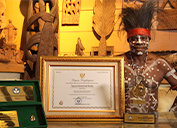PTFI-established Foundation Lauded for Helping Preserve Area Culture

April 6, 2022 - A PT Freeport Indonesia-pioneered art foundation focusing on the cultural preservation of the native Kamoro tribe has been honored by the Indonesian government.
The Maramowe Weaiku Kamorowe Foundation, which is supported by PTFI, was awarded the Anugerah Kebudayaan Indonesia (also known as the Indonesian Cultural Award) from Indonesia’s Ministry of Education and Culture. The award acknowledges the foundation's efforts to preserve and promote the indigenous culture of the Kamoro Tribe.
The award speaks to PTFI’s decades-long commitment to the Indigenous culture of the Papuan tribes near the company’s operations. Gestures of that commitment have included various international exhibitions, art shows and performances, along with mentoring and support provided to the Maramowe, the Kamoro artists who carve their creations from native wood.
"We appreciate the recognition from the government, which solidifies our commitment to the social element of our operations,” said Claus Wamafma, Director and Executive Vice President-Community Relations and Social Responsibility, PTFI. “The company and Maramowe Foundation continue to advance our constructive partnership to benefit all stakeholders."
Introducing art to broader audience
The Corporate Communications department at PTFI works closely with the foundation on various projects to promote the Kamoro artists, introducing their art to a broader audience and helping connect them with potential buyers. The richness of cultural resources in the area surrounding PTFI was first detailed when the company published a book describing the challenges and complexities of the Grasberg mining operations.
Kal Muller, a well-versed writer, photographer and documentary filmmaker specializing in indigenous and traditional societies, was hired as a consultant for “Grasberg,” a book published by Freeport-McMoRan in 1996. (Muller would go on to work for the foundation, and now serves as an advisor.) Working closely with Muller were Luluk Intarti and Greg Probst, Director-Public Affairs, New Orleans.
“Back in the ’90s, Luluk was the administrative assistant for our communications group at Jobsite, and she and I worked with Kal Muller to pull off the first Kamoro Arts and Culture Festival in Mimika in 1998,” Probst said. “It was a big hit, with reporters from international publications like Time and Newsweek in attendance, and it received great press, which really helped the Kamoro artists.”
Intarti left PTFI in the early 2000s to work on the foundation with Muller. Now that he has retired and resides overseas, Intarti leads the foundation, which supports and mentors more than 500 local artists.
"The Kamoro art and culture is fascinating and is comparable with the Asmat culture, which was much more well-known at that time," Muller said. "The opening of a mining operation in a remote part of the world allowed opportunities for the art and culture of those local communities to benefit from the operation because it brought this fascinating Kamoro art and culture to the outside world.”
Limited exposure to carvings
Many Freeport employees and other potential buyers of Kamoro carvings had been exposed to only a limited number and type of carvings. More importantly, while Kamoro artists were adept at carving, they knew little about promoting and selling their artwork beyond their local villages.
“Freeport helped both parties while creating a long-lasting legacy of its operations through the creation of the foundation," Muller said.
"Thanks to Freeport, we can sustain the potential market for the artwork,” Intarti said, noting that Kamoro art has been promoted and exhibited at art shows in Europe, Asia and across the globe.
That said, the foundation’s mission doesn’t revolve only around promoting art, she said.
“The art is really a vehicle for our greater mission, which is to inform, recognize and celebrate this rich Kamoro culture and do so in a way that also can benefit the Kamoro artists and their families through finding new buyers of their work,” Intarti said. Thanks to our foundation, the Kamoro now feel prouder of their traditional way of life.”

Photos: The award acknowledges efforts to preserve and promote the indigenous culture of the Kamoro Tribe; A Maramowe, or Kamoro carver, at work.



 BACK
BACK
SOCIAL
RECOGNITION